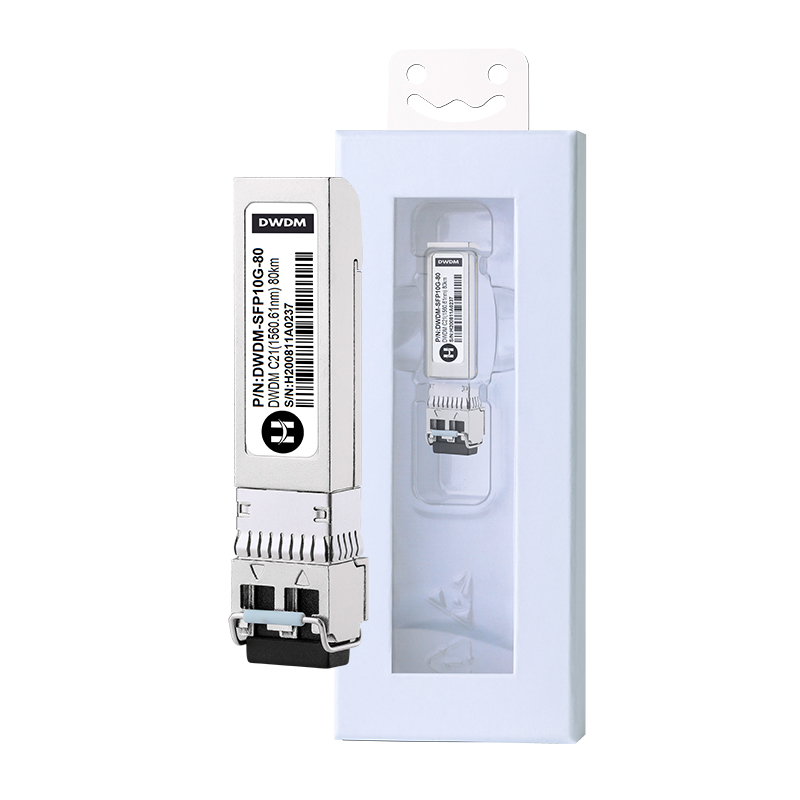10G DWDM SFP+ Transceiver Module (SMF, C21 to C61, 80km, LC, DOM)
Features
DWDM for multiple applications over one duplex fiber
For 10GBASE-ZR Ethernet links
Supported Data Rates: 9.95 Gbit/s - 11.1 Gbit/s with dual CDR
Powerbudget of 23 dB for up to 80 km using an OS2 ITU-T G.652 fiber
WHY USING CDR / 3R / CLOCK-DATA RECOVERY
CDR is the abbreviation for Clock-Data-Recovery.
WHAT DO I USE A CDR FOR?
Physical impacts are influencing the optical signal during the transmission over fiber optic cables. Due to the length of an optical link the signal suffers a time delay deviation which leads to problems in synchronization. In addition an optical fiber attenuates the signal which leads to a degradation of the signal. The physical impacts are linear and non-linear effects which are leading to wave distortion.
This is why a 3R-regeneration will be used:
Re-Amplification (regeneration of amplitude)
Re-Shaping (regeneration of signal waveform)
Re-Timing (regeneration of synchronization)
The transceiver includes a Limiting Amplifier (*1:electrical component which amplifies and reshapes the incoming signal.), which compensates step 1 & 2 at receiver side. For step 3 (Re-Timing) there is an additional CDR chip set integrated in the transceiver.
WHEN DO I HAVE TO USE A TRANSCEIVER WITH CDR?
This question was raised with the introduction of SFP+ modules.
Short summary:
XFP modules are built with CDR on-board as defined in the related MSA-Standard. To realize a cost effective and smaller form-factor this functionality doesn't become part of the SFP+ module. The idea was implementing CDR directly in the host-system of the SFP+ if needed. This would increase the price of the end-devices like switches and routers. A 2R-regeneration (Re-Amplification, Re-Shaping) is already part of the transceiver so it is not mandatory to implement a CDR function.
To realize a standard link this is usually sufficient. Standard links are typically in-house wiring (Multimode), 10km, 20km and 40km point-to-point connections.
But if you are planning to set up a wavelength multiplexing (DWDM), an optical amplifier or transmitting over long distances, you should consider a complete 3R-regeneration. This can be achieved with a CDR chip set either in your DWDM-transponder, host-system or transceiver. Most of the DWDM transponder-systems do have a CDR functionality on board.
WHICH ADVANTAGES COME WITH A CDR?
There are a lot of effects on an amplified DWDM link which have a lot of impact on the transmission signal. For an error-free detection parameters like:
ONSR (Optical signal-to-noise ratio)
BER (Bit-error-ratio)
Input power value
Data rate
Degradation of the signal
have impact on each other. A stable reliable DWDM link can be achieved, if you take the first four points into consideration by planning an amplified DWDM link and in addition eliminating the last point by using a 3R-regeneration with CDR.
SPECIFICATION
| FORM FACTOR | SFP+ | POWERBUDGET (DB) | 23 dB |
| CONNECTOR / POLISH | LC-Duplex PC | TRANSMIT MIN/MAX | 0 dBm / 5 dBm |
| INTERFACE | DWDM | RECEIVER MIN/MAX | -23 dBm / 8 dBm (overload) |
| TYPE | DWDM ZR | WAVELENGTH RX (RANGE) | 1260 - 1620 nm |
| DISTANCE | 80 km | LASER | EML |
| TEMPERATURE RANGE | 0°C - 70°C | RECEIVER TYPE | APD |
| BANDWIDTH | 9.95 Gbit/s - 11.1 Gbit/s | MODULATION | NRZ |
| DIGITAL DIAGNOSTIC MANAGEMENT (DDM) | Yes, internally calibrated | TRANSMIT AND DISPERSION PENALTY | 3.5 dB |
| POWER CONSUMPTION | 2.2 W | DISPERSION TOLERANCE | -500 ps/nm to 1,600 ps/nm |
| CDR | TX and RX | EXTINCTION RATIO | 8.2 dB |
| INBUILT FEC | No | PROTOCOLS | 10G Ethernet, STM-64 |

